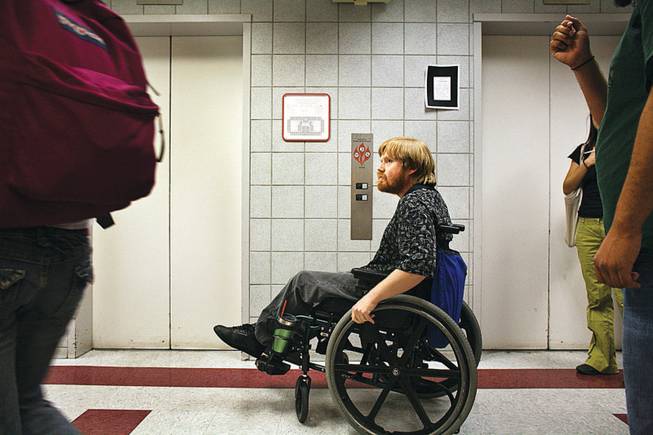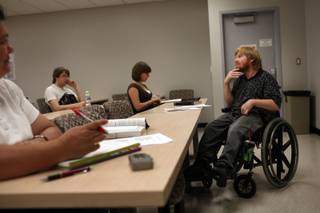
TIFFANY BROWN / LAS VEGAS SUN
UNLV doctoral student James Altman leaves his office at the Flora Dungan Humanities building. He says UNLV has a way to go to become fully accessible.
Tuesday, May 12, 2009 | 2 a.m.
Sun Archives
- Disabled students find a friend in CCSN (4-11-2005)
- Lawmakers plan to address handicapped access issues (11-25-2003)
- Improvements made at Thomas & Mack (9-7-2000)
- Editorial: Disabled access is dreadful (5-28-2000)
- Barriers block path to access (5-21-2000)
The double doors at UNLV’s John S. Wright Hall swing open after James Altman presses a metal button displaying an icon of a person in a wheelchair. But by the time Altman wheels up to the doors, they are closing. One bangs against his arm as he squeezes out of the building.
“When you live the type of life I have to live, a sense of humor is essential,” says Altman, a mop-haired redhead.
Traversing the university grounds, Altman points out the inconveniences that pepper his day-to-day life — the too-steep ramps he struggles to climb in his manual wheelchair, the cracks in the pavement that annoy him with a jolt every few feet.
Altman, 30, a doctoral student in English, relishes showing an able-bodied person the world through his eyes. He can’t walk because the cerebral palsy he has had since birth makes it difficult for him to coordinate his movements.
His primary mission is completing his education. But since fall 1998, when he entered UNLV as a freshman, he has also devoted time to another endeavor: Raising awareness about accessibility on campus for people like him.
For all the improvements the university has made over the years, Altman still sees the work that remains to be done — problems unnoticed by most campus visitors.
His experiences demonstrate that change often begins with a single person. In his years at UNLV, Altman has won scattered victories that have the potential to affect, in some small way, the lives of fellow wheelchair users years down the line.
As a result of Altman’s presence, for instance, the English department has prioritized plans to renovate its cramped graduate student offices, which interim department Chairman Douglas Unger jokingly called a “Hobbit hole.”
Altman, who taught English 101 this semester, is relegated to a desk in the front portion of one office. His fellow graduate students work in the back of the room, at five desks crammed together in space accessible only via a narrow walkway barely wide enough to fit a wheelchair. The office next door is just as crowded.
The department had long wanted to renovate the space so graduate students could work and interact with one another in more comfortable quarters. But Altman was the motivation for getting it done, Unger says.
“It was wrong that he should be isolated from the others in that collaborative process that I think all Ph.D. students should actively engage in,” Unger says.
UNLV has requested $116,000 in federal money for the remodeling, which would allow wheelchair users to work alongside their colleagues.
Unger is working with administrators to develop an alternate plan:
If the College of Liberal Arts says remodeling is its top priority for capital improvements, the university will tear down office walls to open up space. Gerry Bomotti, UNLV’s senior vice president of finance and business, says he’s on board.
Students such as Altman who have physical disabilities make up a small minority of the 300 or so students who seek the assistance of UNLV’s Disability Resource Center each semester, says Clark Hochstetler, the center’s director. (The center also serves students with learning and other disabilities.)
Juanita Fain, vice president of student affairs, says that even though UNLV complies with federal laws related to accessibility, “that still doesn’t always mean that a person has the accessibility that they like.”
UNLV is responsive to individual concerns, she and Hochstetler say. This year, for instance, after a dean observed one student having trouble opening a door in the library, university staff installed an electric door, Hochstetler says.
Altman has his own story: In 2003 he arrived at a class to find fellow students seated in a room whose main area was accessible only by stairs. After his mother wrote officials an e-mail saying “he feels separated and segregated from the rest of the classroom population,” one administrator replied, “The professor had alerted us already, and we are in the process of changing the class to a different room.”
Altman says accessibility at UNLV has improved “slightly and by degrees” since he arrived more than a decade ago. The paving on campus pathways is generally better than it was.
Some stairs have been replaced with ramps — a change that could prevent accidents like the one that won Altman a $9,999 out-of-court settlement shortly after he arrived at UNLV.
In September 1998, as Altman remembers it, a stranger giving directions pointed him toward a short flight of steps outside the William D. Carlson Education Building. It was a rainy morning, and dark. No signs or handrails were present to alert Altman to the looming danger. Sitting in his chair, he could not see the ground directly in front of him.
By Altman’s account, his wheelchair tipped over the edge of the three-step staircase: “I took a header,” he recalls wryly.
“What I remember was opening my eyes. I was wearing a black shirt with a great big Garfield on it, and I remember seeing red streaks on that shirt where they hadn’t been before, and they were starting to mix with the rainwater.”
He had broken his jaw and some front teeth that were later removed.
According to a photograph Altman’s mother took following her son’s harrowing mishap, the university installed a sign by the stairs that resembled a no-smoking sign, but with an icon of a person in a wheelchair crossed out instead of a cigarette. That sign was then replaced with another one indicating the presence of stairs.
Finally, the university replaced the steps with a ramp.
The small victories Altman has won along the way do not mean the university doesn’t still have work to do.
Journeying across campus recently, Altman stops outside Archie C. Grant Hall and points to what appears to be a miniature speed bump with gravel lining one side. This is the surface wheelchair users pass over to get from a campus pathway to a parking lot.
Altman says buttons used to operate electric doors on campus often malfunction. Try the ones at the school’s new Science and Engineering Building, he suggests.


Join the Discussion:
Check this out for a full explanation of our conversion to the LiveFyre commenting system and instructions on how to sign up for an account.
Full comments policy